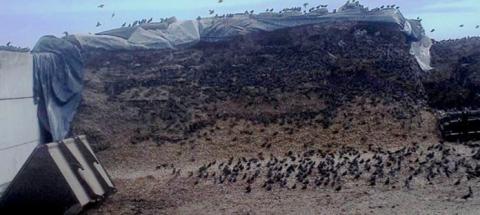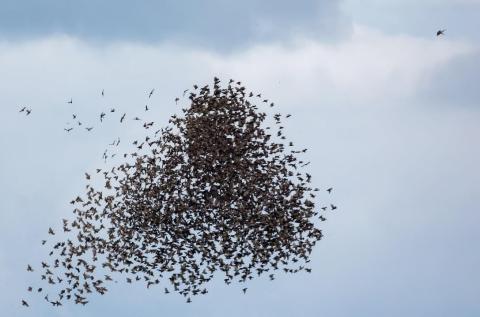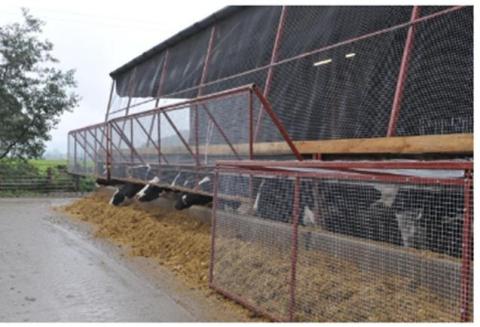Dr Natalie Meades: IBERS, Aberystwyth University.
December 2023
Image by Woods, et al. (2022).
- Starlings are described as pests on farm where they help themselves to the energetically rich fractions within livestock feed, which can have negative effects on animal performance and feed economics.
- The faeces of starlings along with the faeces of any wild bird pose a potential risk pathway for introducing harmful pathogens to livestock and humans onto farm. Moreover, starling faeces are acidic and are therefore potentially damaging to infrastructure.
- Starlings along with any wild bird in the UK are protected under the Wildlife and Countryside Act 1981. Therefore, it is important to be fully aware of what can and cannot be done when working towards mitigating and preventing starlings from coming onto farm.
- There are many deterrent strategies that can be implemented on farm to prevent and control starling infestations. However, one of the main challenges with implementing deterrents on farm is that starlings can become habituated to them over time.
Starlings in the UK
The UK is home to a resident population of starlings which is reported to have declined since the 1980s, as such they are listed in the UK Birds of Conservation Concern 5 within the red list, which was last reviewed in 2021. The UK resident starling population is added to during the early Autumn months (September-November) following the migration of European starlings. The European starlings overwinter in the UK and return to Europe from February-
March. As such, the UK typically sees a peak in the starling population from around December to January.
The typical habitats of starlings consist of, woodland, upland, urban, suburban, marine, intertidal, wetland grassland and farmland areas. Starlings typically do not roost and forage within the same location, they travel away from roosting sites in search of food and have been known to have several feeding sites. Moreover, it is reported within the literature that starlings may travel up to 50 miles from roosting sites to forage for food.
Starlings on Farm – The Problems
It is the European starling population that typically causes issues on farms within the UK. This problem is not just unique to the UK, in fact America receive these migratory birds as well. Starlings are reported to arrive on farm early in the morning and remain until dusk before returning to roosts. Systems that involve the housing of livestock indoors can be seen as attractive environments for starlings, due to these systems providing easy access to feed and water. As such, finding food within these systems is far easier for starlings in comparison to natural feeding habits which involve foraging for invertebrates.
Starlings are particularly problematic in livestock systems that feed total mixed rations (TMR) and concentrates, where starlings have preference for energetic nutrients within feed such as starch and fats. A study conducted in Kansas, USA investigated the depredation of five different cattle diets and found starlings to have the greatest preference for the starch
fraction within diets leaving behind the protein and fibre fractions. Moreover, clamps containing whole crop silages such as maize silage are particularly attractive to these birds with regards to the high starch composition of maize kernels. As such, this creates competition between livestock and starlings for the energetic nutrients within feed. Therefore, a heavy starling infestation on farm may result in livestock not receiving sufficient energy within the diet as per expected from ration formulations. This is particularly problematic regarding animal performance and production losses. Moreover, at energetically demanding times such as late gestation and during lactation the depredation of energetic nutrients within rations may result in energy deficits and as such make animals more susceptible to developing certain metabolic diseases.
Feed makes up a considerable proportion of on farm variable costs, therefore it is important that feed is used efficiently to maximise performance and to minimise economic losses. It has been reported that starlings consuming livestock feed can result in significant economic losses to producers. To put this into perspective, an average starling weighing 85 g has been reported to consume approximately 1 kg of feed over a 30-day period. Likewise, a study conducted on five dairy farms within the East Midlands, UK that suffered from starling infestations, observed starlings to consume on average 11.9 tonnes of feed over a single winter feeding period. Moreover, a study conducted on the Somerset Levels, UK in 2012 aimed to quantify the cost of starling infestations on farm and estimated it to cost £135 per day per 100 cows excluding animal health costs. With the price of feed increasing since 2012, it is worrying to think what the economic cost of starling infestations would be today.
Another potential problem with starling infestations is with regards to their acidic faeces, which has the potential to damage infrastructure on farm over time. Moreover, the faeces of starlings along with the faeces from any wild bird, present a potential risk pathway for introducing pathogens onto farm, which can have negative effects on both livestock and human health.
Starling Deterrents
Various deterrent strategies can be implemented on farm in the aim of mitigating or completely removing starlings from site. However, all wild birds, their eggs and nests are protected under the Wildlife and Countryside Act 1981 in the UK. Therefore, it is important to be aware of what deterrent strategies can and cannot be legally carried out on farm and where licenses from National Resources Wales (NRW) are required. According to NRW, deterrents in which a license is not required include, scaring techniques, excluding birds from a site, making a site less attractive to birds and encouraging birds away from sensitive sites and towards areas where they will not cause a problem. Although there are a wide number of options available, it is important to consider the effects and appropriateness of using deterrents on wider areas. For example, certain deterrents may not be appropriate for use near residential areas, infrastructure, public services (schools, hospitals) or within certain ecosystems.
One of the main challenges with implementing deterrents on farm is that starlings can become habituated to them. In other words, the effectiveness of the deterrent declines over time due to the birds becoming accustomed to them. As such, they become ineffective. Furthermore, the Agriculture and Horticulture Development Board (AHDB) advises that the most effective method of deterring birds is to plan ahead and put strategies in place before the birds migrate back to the UK (October/ November) and establish feeding on farm. This way the problem can potentially be prevented rather than having to spend additional time, money and resources to resolve it.
Visual Deterrents
Visual deterrents are methods that are used to discourage or repel pests from environments using visual stimuli. Such deterrents are commonly used within crop fields and where small fruits are grown. Examples of these include the use of stationary effigies (scarecrows), scary eye balloons, reflective materials and predator decoys, to name a few. However, their effectiveness is somewhat limited as birds often become accustomed to them over time.
The use of lasers (Light Amplification by Stimulated Emission of Radiation) within livestock housing units have been proposed as visual deterrents for starlings. Lasers shine through housing environments and over feed passageways in the aim of distorting the vision of the birds and therefore creating an undesirable environment for them to reside in. This is particularly problematic for the birds, as birds rely on vision to navigate, detect food and detect threats within the environment. The use of lasers have been demonstrated to be effective in the field where a study in Rhode Island, USA observed the use of laser scarecrows with a 50 mW green laser diode (532 nm) with a beam diameter of 14 mm (similar to the lights observed at light shows in music venues) had the effect of reducing crop damage by European starlings by 33% in comparison to unprotected crops. However, there is little peer reviewed information to indicate the long-term success of using lasers within livestock systems in the UK. Likewise, it is important when considering using lasers that they do not cause harm to the eyesight of livestock or humans working in housing environments.
Auditory Deterrents
Auditory deterrents involve the use of sound to startle birds and encourage them to move away from a particular environment. The regular discharging of propane canons or firecrackers are commonly used within the field to deter birds from crops. However, their suitability in livestock systems is limited with regards to distress to livestock. Moreover, it may not be appropriate to use them close by to residential areas.
An alternative auditory deterrent method involves the use of sonic nets. Sonic nets involve the use of sound waves within a confined space to disrupt the acoustic communication between birds, therefore making it challenging for birds to receive calls. This can be particularly problematic for birds regarding signaling for danger, sounding mating calls, asserting territory and for signaling for the quality and location of food. As such, this creates an environment unfavorable for the birds and encourages them to move away from the area. The hearing range for starlings is reported to be between 0.7 - 8.7 KHz with peak sensitivity at around 2 kHz. Moreover, the frequency range of starling vocalization is thought to be between 0.25 - 12.0 KHz, with most calls including predator alarm calls being between 3-9 KHz. As such, there has been research associated with the use of sonic nets set within these parameters. A study in Virginia, USA investigated the effect of using a sonic net with a beam sound of 2 – 10 KHz and an amplitude of 80 dB sound pressure for 8 hours per day over three test days. The results of the study observed starlings to deter from the food source that was associated with the sonic net by approximately 46%. Moreover, a study conducted on 10 dairy farms in Cornwall, UK investigated the effect of using a 2 - 10 KHz sonic net with a sound pressure of 80 dB over maize silage clamp faces. The use of the sonic net had the effect of reducing starlings on the clamp face by 89% over 14 days of use. These studies demonstrate the use of sonic nets to be a promising technology for deterring starlings, however these studies were conducted over short periods of time and therefore this method needs testing over a longer period to determine the long-term effectiveness.
Figure 1: Example of a Sonic Net setup on a maize silage clamp. Image by Woods, et al. (2022).
Exclusion Deterrents
Exclusion involves the use of physical barriers to deter pests and is often one of the most effective deterrent methods. The use of physical barriers such as < 28 mm hole netting, roller blinds and covering up any feedstores and clamp faces (especially for maize silage) are commonly used as exclusion deterrents for starlings. Implementing such infrastructure on farm can be costly, however with regular maintenance they can be effective for long time periods. A case study reported by Farming Connect involving a Welsh dairy farm near Oswestry is currently testing the use of £30, 000 worth of welded wire mesh panels as an exclusion deterrent for starlings, which currently consume maize and other cereals within TMR. Although no data were presented int eh case study, it was estimated that 50,000 – 100,0000 starlings were costing the farm £15, 000 a month through feed losses. Moreover, from the starlings consuming the energy fraction within TMR it was reported that cows were producing 2 litre less of milk per day per cow and having negative effects on fertility as a result.
Nutrition and Feed Form
Starlings are attracted to the energetically rich fractions within livestock feeds. Therefore, there has been interest in the alteration of diets in the aim of deterring them from farm. One such method is moving away from using appealing feeds such as maize silage and concentrates. However, this may not be practical or possible in certain cases. The addition of additives in feed to deter starlings may present an alternative option. Although this would only be permitted if the additive was not toxic to the bird. A study demonstrated mixing food grade garlic oil as impregnated granules into feed sources to have the effect of repelling European starlings. However, no studies have been conducted with regards to the inclusion of garlic in livestock feed as a deterrent for starlings on farm. Starlings lack the enzyme sucrase within their gastrointestinal tract. Therefore, the overconsumption of sucrose may result in birds developing digestive upsets, diarrhoea and dehydration. No peer reviewed publications were found with regards to the use of sucrose within livestock diets as a deterrent for starlings. However a technical bulletin by Oregon State University suggests the use of sucrose water sprays to deter birds from small fruits has been trialed in the Colombia Plateau. However, no data or publications were found associated with such deterrent.
Another area of interest is altering feed form to make feed more difficult for the starlings to eat. A study conducted in the East Midlands, UK, observed starlings to have a greater preference for rolled barley in comparison to ground barley in complete feeds fed todairy cattle. Other studies have suggested altering the size of feed particles. A study investigated feeding six different diameters of pellets (2.2, 1.9, 1.3, 0.9 0.5 and 0.4 cm) and observed pellets >0.9 cm in diameter or larger to deter birds, thereby reducing the consumption of the feed by >79%. However, it must be remembered that when using dietary additives or when changing feed form, consideration is made as to the impact on rumen metabolism.
Birds of Prey
Birds of prey such as falcons and hawks have been used as deterrents of certain bird species. A study investigated the introduction of the New Zealand falcon to vineyards as a deterrent for starlings, blackbirds and song thrushes eating grapes. The study observed there to be less damage to grapes within vineyards when falcons were present. In the UK this may involve birds of prey such as Harris hawks and Sparrowhawks. Birds of prey are predators and are therefore capable of hunting starlings, therefore acting as visual deterrents. Likewise, the flight pattern of the bird of prey may deter birds from certain areas as well as from roosting sites. Moreover, the call of the bird of prey may act as an auditory deterrent also.
Summary
Starlings can be described as pests on farm where they consume the energetically rich fractions of livestock feeds. As such, this can lead to negative effects on animal performance and feed economics. Moreover, the faeces of starling pose a potential risk pathway for the transmission of harmful pathogens on to farm which could be damaging to livestock and human health. Likewise, the faeces of starlings are acidic and over time could potentially lead to the damage of infrastructure. Therefore, it is not surprising efforts are made to deter and prevent starlings from coming onto farm. There are many deterrent strategies out there, however it is important that be aware of what can and cannot be legally carried out towards these birds and when licenses are required, regarding these birds are protected under the Wildlife and Countryside Act 1981. Strategies that do not require licenses include, visual, auditory, exclusion and the use of falconry, nutrition and feed form. However, one of the main challenges with implementing deterrents on farm is that starlings can become habituated to them over time.





